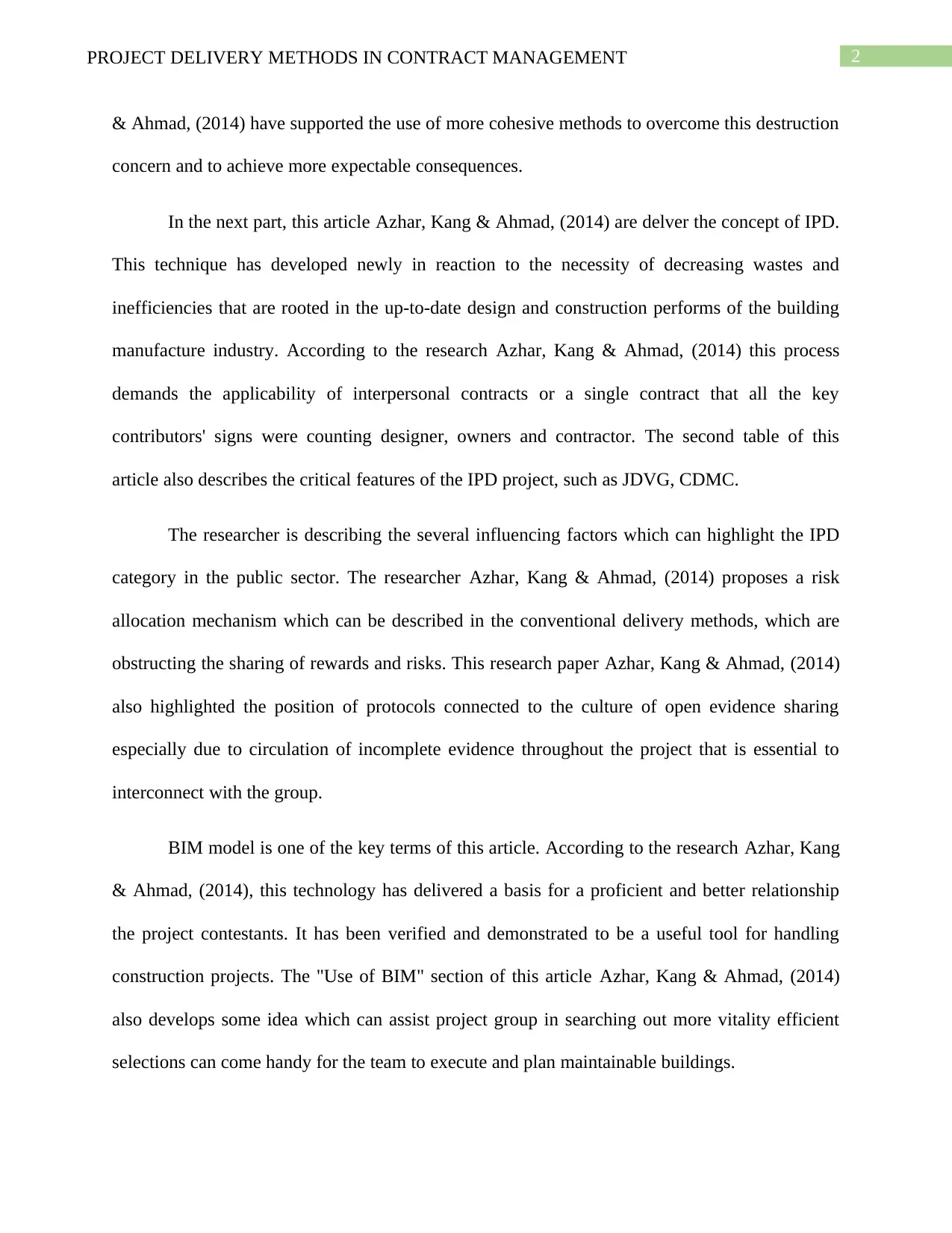Analysis of Project Delivery Methods in Contract Management
VerifiedAdded on 2022/08/15
|6
|1214
|14
Report
AI Summary
This report examines various project delivery methods within contract management, drawing upon the research of Azhar, Kang & Ahmad (2014) and other sources. It delves into the concepts of Integrated Project Delivery (IPD), Design-Bid-Build (DBB), and Building Information Modeling (BIM), highlighting their roles and influences in construction projects, particularly within the public sector. The report discusses the advantages and disadvantages of different methods, focusing on factors such as risk allocation, data sharing, and the use of BIM for improved project outcomes. It also explores the potential of IPD in reducing waste and inefficiencies, emphasizing the importance of collaboration and early involvement of key contributors. Furthermore, the report touches upon the significance of BIM in facilitating efficient relationships and sustainable building practices. The conclusion suggests that the construction industry requires alternative delivery approaches, and it identifies areas where BIM technology can further enhance project delivery.

Running head: PROJECT DELIVERY METHODS IN CONTRACT MANAGEMENT
PROJECT DELIVERY METHODS IN CONTRACT MANAGEMENT
Name of the Student:
Name of the University:
Author’s Note:
PROJECT DELIVERY METHODS IN CONTRACT MANAGEMENT
Name of the Student:
Name of the University:
Author’s Note:
Paraphrase This Document
Need a fresh take? Get an instant paraphrase of this document with our AI Paraphraser

1PROJECT DELIVERY METHODS IN CONTRACT MANAGEMENT
Introduction:-
This research paper of Azhar, Kang & Ahmad, (2014) is developing the idea of
influencing factors of construction project delivery management. These features are generally
categorizing under organizational, legal and technical categories. Additionally, the responsibility
of data modelling to substitute the integration in project delivery is deliberated. In this research
paper also explore these factors and recommend an evidence modelling method to evade the
obstructions. The researcher Azhar, Kang & Ahmad, (2014) of this article presented an
evaluation of public delivery approaches used in the public sector for distributing the
construction projects.
Discussion:-
In this report, the writer is describing this article Azhar, Kang & Ahmad, (2014) which
makes concepts of project delivery and contract management. In this article, the researcher
introduces the term "IPD" which can be commonly used in the project delivery process. This
research paper Azhar, Kang & Ahmad, (2014) is also describing the example of "building
information modelling" which can decrease the issues of IPD implementation.
"Common project delivery system" is one section of this article which can develop the
idea of "DBB" methods of public construction projects. This article Azhar, Kang & Ahmad,
(2014) states that the role is generally allocating to suppliers. The construction manager may also
execute the project construction under the correct extreme price. In the first table of the article,
Azhar, Kang & Ahmad, (2014) provides an evaluation of usual project delivery systems
performances applied in public-sector construction. The researchers of this article Azhar, Kang
Introduction:-
This research paper of Azhar, Kang & Ahmad, (2014) is developing the idea of
influencing factors of construction project delivery management. These features are generally
categorizing under organizational, legal and technical categories. Additionally, the responsibility
of data modelling to substitute the integration in project delivery is deliberated. In this research
paper also explore these factors and recommend an evidence modelling method to evade the
obstructions. The researcher Azhar, Kang & Ahmad, (2014) of this article presented an
evaluation of public delivery approaches used in the public sector for distributing the
construction projects.
Discussion:-
In this report, the writer is describing this article Azhar, Kang & Ahmad, (2014) which
makes concepts of project delivery and contract management. In this article, the researcher
introduces the term "IPD" which can be commonly used in the project delivery process. This
research paper Azhar, Kang & Ahmad, (2014) is also describing the example of "building
information modelling" which can decrease the issues of IPD implementation.
"Common project delivery system" is one section of this article which can develop the
idea of "DBB" methods of public construction projects. This article Azhar, Kang & Ahmad,
(2014) states that the role is generally allocating to suppliers. The construction manager may also
execute the project construction under the correct extreme price. In the first table of the article,
Azhar, Kang & Ahmad, (2014) provides an evaluation of usual project delivery systems
performances applied in public-sector construction. The researchers of this article Azhar, Kang

2PROJECT DELIVERY METHODS IN CONTRACT MANAGEMENT
& Ahmad, (2014) have supported the use of more cohesive methods to overcome this destruction
concern and to achieve more expectable consequences.
In the next part, this article Azhar, Kang & Ahmad, (2014) are delver the concept of IPD.
This technique has developed newly in reaction to the necessity of decreasing wastes and
inefficiencies that are rooted in the up-to-date design and construction performs of the building
manufacture industry. According to the research Azhar, Kang & Ahmad, (2014) this process
demands the applicability of interpersonal contracts or a single contract that all the key
contributors' signs were counting designer, owners and contractor. The second table of this
article also describes the critical features of the IPD project, such as JDVG, CDMC.
The researcher is describing the several influencing factors which can highlight the IPD
category in the public sector. The researcher Azhar, Kang & Ahmad, (2014) proposes a risk
allocation mechanism which can be described in the conventional delivery methods, which are
obstructing the sharing of rewards and risks. This research paper Azhar, Kang & Ahmad, (2014)
also highlighted the position of protocols connected to the culture of open evidence sharing
especially due to circulation of incomplete evidence throughout the project that is essential to
interconnect with the group.
BIM model is one of the key terms of this article. According to the research Azhar, Kang
& Ahmad, (2014), this technology has delivered a basis for a proficient and better relationship
the project contestants. It has been verified and demonstrated to be a useful tool for handling
construction projects. The "Use of BIM" section of this article Azhar, Kang & Ahmad, (2014)
also develops some idea which can assist project group in searching out more vitality efficient
selections can come handy for the team to execute and plan maintainable buildings.
& Ahmad, (2014) have supported the use of more cohesive methods to overcome this destruction
concern and to achieve more expectable consequences.
In the next part, this article Azhar, Kang & Ahmad, (2014) are delver the concept of IPD.
This technique has developed newly in reaction to the necessity of decreasing wastes and
inefficiencies that are rooted in the up-to-date design and construction performs of the building
manufacture industry. According to the research Azhar, Kang & Ahmad, (2014) this process
demands the applicability of interpersonal contracts or a single contract that all the key
contributors' signs were counting designer, owners and contractor. The second table of this
article also describes the critical features of the IPD project, such as JDVG, CDMC.
The researcher is describing the several influencing factors which can highlight the IPD
category in the public sector. The researcher Azhar, Kang & Ahmad, (2014) proposes a risk
allocation mechanism which can be described in the conventional delivery methods, which are
obstructing the sharing of rewards and risks. This research paper Azhar, Kang & Ahmad, (2014)
also highlighted the position of protocols connected to the culture of open evidence sharing
especially due to circulation of incomplete evidence throughout the project that is essential to
interconnect with the group.
BIM model is one of the key terms of this article. According to the research Azhar, Kang
& Ahmad, (2014), this technology has delivered a basis for a proficient and better relationship
the project contestants. It has been verified and demonstrated to be a useful tool for handling
construction projects. The "Use of BIM" section of this article Azhar, Kang & Ahmad, (2014)
also develops some idea which can assist project group in searching out more vitality efficient
selections can come handy for the team to execute and plan maintainable buildings.
⊘ This is a preview!⊘
Do you want full access?
Subscribe today to unlock all pages.

Trusted by 1+ million students worldwide

3PROJECT DELIVERY METHODS IN CONTRACT MANAGEMENT
The reader of this research Azhar, Kang & Ahmad, (2014) can realize that the IPD
process can agree with the BIM techniques which can be permitting project contributors to
cooperate early on the project. This research article can raise some findings which can get the
advantage from the skill already in hand irrespective of its volumes and lengths. This paper
Azhar, Kang & Ahmad, (2014), also established some links between BIM and IPD. BIM cloud is
the one crucial part which is discussing in this paper. BIM cloud permits data from some
miscellaneous applications over a central source platform to interoperate and exchange evidence.
Conclusion:-
The research reader was detecting that while specific issues need substantial variations
like changing obtaining rules related to a public building, others could be reaching over applying
tools that are previously in use. The Researchers Azhar, Kang & Ahmad, (2014) also argued
specific areas where the decorated concerns can be developing over the applicability of BIM
technology. The outcome of this research is that the building manufacture industry is in a severe
requirement of other delivery approaches.
The reader of this research Azhar, Kang & Ahmad, (2014) can realize that the IPD
process can agree with the BIM techniques which can be permitting project contributors to
cooperate early on the project. This research article can raise some findings which can get the
advantage from the skill already in hand irrespective of its volumes and lengths. This paper
Azhar, Kang & Ahmad, (2014), also established some links between BIM and IPD. BIM cloud is
the one crucial part which is discussing in this paper. BIM cloud permits data from some
miscellaneous applications over a central source platform to interoperate and exchange evidence.
Conclusion:-
The research reader was detecting that while specific issues need substantial variations
like changing obtaining rules related to a public building, others could be reaching over applying
tools that are previously in use. The Researchers Azhar, Kang & Ahmad, (2014) also argued
specific areas where the decorated concerns can be developing over the applicability of BIM
technology. The outcome of this research is that the building manufacture industry is in a severe
requirement of other delivery approaches.
Paraphrase This Document
Need a fresh take? Get an instant paraphrase of this document with our AI Paraphraser

4PROJECT DELIVERY METHODS IN CONTRACT MANAGEMENT
References:-
Azhar, N., Kang, Y., & Ahmad, I. U. (2014). Factors influencing integrated project delivery in
publicly owned construction projects: an information modelling perspective. Procedia
Engineering, 77, 213-221.
References:-
Azhar, N., Kang, Y., & Ahmad, I. U. (2014). Factors influencing integrated project delivery in
publicly owned construction projects: an information modelling perspective. Procedia
Engineering, 77, 213-221.

5PROJECT DELIVERY METHODS IN CONTRACT MANAGEMENT
Bibliography:-
Bilbo, D., Bigelow, B., Escamilla, E., & Lockwood, C. (2015). Comparison of construction
manager at risk and integrated project delivery performance on healthcare projects: A
comparative case study. International Journal of Construction Education and Research,
11(1), 40-53.
Carpenter, N., & Bausman, D. C. (2016). Project delivery method performance for public school
construction: Design-bid-build versus CM at risk. Journal of construction engineering
and management, 142(10), 05016009.
Franz, B., Leicht, R., Molenaar, K., & Messner, J. (2017). Impact of team integration and group
cohesion on project delivery performance. Journal of construction engineering and
management, 143(1), 04016088.
Nawi, M. N. M., Haron, A. T., Hamid, Z. A., Kamar, K. A. M., & Baharuddin, Y. (2014).
Improving integrated practice through building information modeling-integrated project
delivery (BIM-IPD) for Malaysian industrialised building system (IBS) Construction
Projects. Malaysia Construction Research Journal (MCRJ), 15(2), 1-15.
Suprapto, M., Bakker, H. L., Mooi, H. G., & Moree, W. (2015). Sorting out the essence of
owner–contractor collaboration in capital project delivery. International Journal of
Project Management, 33(3), 664-683.
Bibliography:-
Bilbo, D., Bigelow, B., Escamilla, E., & Lockwood, C. (2015). Comparison of construction
manager at risk and integrated project delivery performance on healthcare projects: A
comparative case study. International Journal of Construction Education and Research,
11(1), 40-53.
Carpenter, N., & Bausman, D. C. (2016). Project delivery method performance for public school
construction: Design-bid-build versus CM at risk. Journal of construction engineering
and management, 142(10), 05016009.
Franz, B., Leicht, R., Molenaar, K., & Messner, J. (2017). Impact of team integration and group
cohesion on project delivery performance. Journal of construction engineering and
management, 143(1), 04016088.
Nawi, M. N. M., Haron, A. T., Hamid, Z. A., Kamar, K. A. M., & Baharuddin, Y. (2014).
Improving integrated practice through building information modeling-integrated project
delivery (BIM-IPD) for Malaysian industrialised building system (IBS) Construction
Projects. Malaysia Construction Research Journal (MCRJ), 15(2), 1-15.
Suprapto, M., Bakker, H. L., Mooi, H. G., & Moree, W. (2015). Sorting out the essence of
owner–contractor collaboration in capital project delivery. International Journal of
Project Management, 33(3), 664-683.
⊘ This is a preview!⊘
Do you want full access?
Subscribe today to unlock all pages.

Trusted by 1+ million students worldwide
1 out of 6
Related Documents
Your All-in-One AI-Powered Toolkit for Academic Success.
+13062052269
info@desklib.com
Available 24*7 on WhatsApp / Email
![[object Object]](/_next/static/media/star-bottom.7253800d.svg)
Unlock your academic potential
Copyright © 2020–2025 A2Z Services. All Rights Reserved. Developed and managed by ZUCOL.





